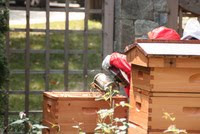







We didn't exactly follow standard beekeeping procedure on this, but my colonies recently swarmed (without our knowledge) and left us in a confusing situation. A swarm is a natural occurrence for a hive as their population grows so large that they no longer have strong pheromones from the queen, or they do not have enough space, resulting in the creation of new queen cells while a large portion of the colony flies off with the old queen to a destination that scout bees have located. We hope that ours went to a nearby park. I missed the queen cells that were the warning signs of a swarm (although my mom captured a picture on the bottom left that may have been their departure gathering), and when I next went in the colony, there were 7 queen cells. 3 of them were in a deep that I had borrowed from my mentor Toni Burham. So, because the boxes are on loan until she can find a better home for them, we decided to start a nuc, which is a colony usually contained in one deep that can be sold as a starter for a new colony- basically a bee colony on a small scale. We took off the box and sat it a few yards away from the colonies, using more borrowed material (including a screened inner cover giving them better ventilation). The nuc has become my sister's "training project," preparing her to become my dad's cobeekeeper when I am away in China for the year. She hopes to grow another colony. Starting nucs from local bees (my hives came from nucs from a local beekeeper, and the fathers for this new nuc will be local as well) is important for supporting the local bee community as well as creating a strain of bees better adapted to our area rather than importing them. While bringing in new genetic material can often be helpful for many issues such as hygenic behavior, local bees are ready for the issues such as tempertature that face them here.


